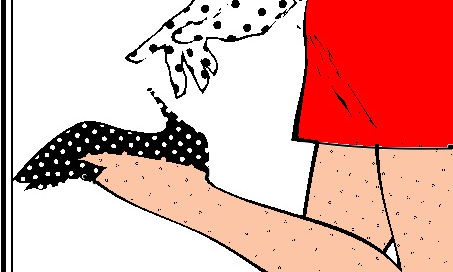A Short History of Shoes
The First Shoes
Of all the appendages of the human body it is the foot that takes the most abuse. The foot must support the weight of the body during the process of walking while traversing unfriendly habitat. Our ancestors walked on hot sands, rocky ground, and forested areas. These areas contained thorny plants and other things that posed a hazard to unprotected feet. In addition to this, some humans migrated north into cold climates making protection of the feet from cold a priority. Because of this, humans began making apparel to protect the foot early in our history. Some experts believe that the first shoes appeared somewhere between 30,000 and 50,000 years ago. The base this upon measurements of the bones that make up the foot of fossilized human remains.
Sandals Appear as the First Shoes
Humans living in tropical climates probably developed the first form of sandal. This led in turn was the first form of shoe in history. These early sandals would have consisted of strands of grass or leather plaited together to form a sole. Straps held it to the foot. The Egyptians used papyrus for the soles of their shoes. In colder climates, the first shoes were simple bags constructed from leather. These slipped over the foot giving some protection from rocky terrain and cold. Grass or leaves stuffed into these early foot bags provided insulation from cold during cold weather.
The simple plaited sandal soon evolved into sandals that are more sophisticated. These stood up to wear better and provided more protection. The "foot bag" probably evolved into the moccasin worn by many northern peoples.
The Shoe Evolves
Shoemaking evolved through the ages to produce ever more sophisticated and elegant shoes. During the Middle Ages in Europe cobblers crafted shoes more for style than for comfort. They developed many ornate styles of shoes for the aristocracy. Different classes of people wore different types of shoes. Commoners wore simple shoes and the higher the social class the more elegant the shoe. The high heel shoe first made its appearance in history during this time. It was a wooden platform shoe that appeared around the 1500's. This shoe has evolved into the elegant stiletto heels worn by fashionable ladies today.
Right And Left Shoes
No matter what class a person belonged to, up until the 1800's function trumped comfort in shoe construction. There was no distinction between the right and left foot and there were only two basic sizes. This began to change in the early 1800's as foot differentiation started appearing on the cobbler's bench.
Machine Made Shoes
All parts of the shoe were hand made up until 1845. In that year a machine called the rolling machine, which compressed the leather of the sole to allow longer wear, came into use. The next revolution in the history of shoes came in 1858. A shoemaker named Lyman R.Blake invented a machine to sew the upper shoe to the sole. He based his invention on sewing machine technology invented by Elias Howe in 1846. A few years later, on January 24, 1871, Charles Goodyear Jr. invented a machine to sew the parts of the shoe together. Humphrey O'Sullivan developed the rubber heel to replace the leather heel in 1899.
Synthetic Materials for Shoes
Modern day shoes are comp
letely machine made. There are no parts of the manufacturing process involving hand labor. Modern day techniques and materials have replaced traditional methods. Rubber, plastic and cloth have replaced leather. Leather still finds in expensive, dress style shoes. Gluing has replaced stitching in most athletic shoes.
The shoe has come a long way since those first sandals constructed from plaited grass and leather. Modern shoes provide the ultimate protection, comfort and style. This was in contrast to the primitive shoes endured by our ancestors.
From the Book:
A History of the Transportation Revolution
A History of the Transportation Revolution covers the history of the evolution of major modes of human transportation. The book provides interesting events in the development of walking, roads, airships, bicycles, aviation, kites, railroads, jet engines and rockets.






